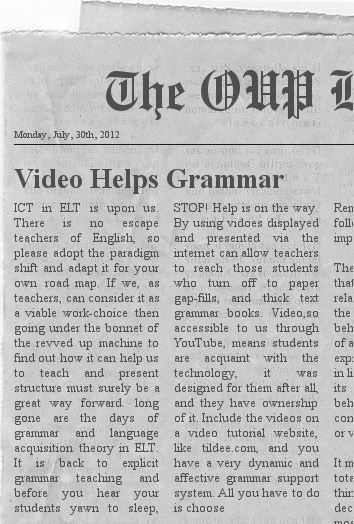 In this post, David Mearns, a teacher in Turkey, discusses the benefit of using video to show grammar in an authentic context and gives a few tips on how to teach grammar using video.
In this post, David Mearns, a teacher in Turkey, discusses the benefit of using video to show grammar in an authentic context and gives a few tips on how to teach grammar using video.
I have been working in Turkey as an ELT practitioner for seventeen years. I became very interested in ICT-ELT two years ago, and began explicitly including it in my syllabus, as a way to further engage Turkish teenage students. At the tail-end of 2010, after having presented on the subject at many conferences, I realised that many of my colleagues were also very interested in the paradigm shift happening in ELT. So, I started to put the ICT-ELT message out to the Turkish provinces. Now after a year of observing teachers, and receiving a great deal of feedback on ICT-ELT, I can see an extraordinary change in people’s attitudes to the exciting possibilities of using technology in (and out of) the classroom.
Since grammar is now having a much welcomed resurgence in popularity with teachers (oh how I despised those, for the most part, years of ‘language acquisition is the only way’ in ELT), I feel it only right to concur with the new focus on grammar, and share a great way for teachers to help make it much more affective for both teachers to present, and for students to enjoy learning the structures they generally find tedious to work at.
I propose that by using video to show how grammar is used in an authentic context, and by having it in the syllabus as both a scaffolding and consolidation stage of understanding structure, students will (and do) engage much more across each form being learned.
I appreciate that the use of video is not new, but I reckon that with it being included under the umbrella of ICT-ELT it has even more effective and affective outcomes.
ICT-ELT
 The website I started using last year, and have continued to do so, is www.tildee.com. This amazing website is a free platform that allows you to upload tutorials with consummate ease. It acts just like a Word document when you are typing and putting pictures, video or links to enhance your grammar point. Here is a Tildee Video Feed-Forward that I made to show how easy it is to access and use.
The website I started using last year, and have continued to do so, is www.tildee.com. This amazing website is a free platform that allows you to upload tutorials with consummate ease. It acts just like a Word document when you are typing and putting pictures, video or links to enhance your grammar point. Here is a Tildee Video Feed-Forward that I made to show how easy it is to access and use.
Now that you have seen how easy it is to sign up and use (you don’t have to sign up, but it is better to do so, as you then have your own account where your video tutorials are stored), it is time to see which videos I have used to help students further engage with the process of learning grammar structures.
Note, although I condone video as a means of teaching grammar, I still believe there has to be a balanced mix of traditional and ICT methods if it is to be successful. Yet, even so, it is the ICT-video springboard paradigm that makes it so appealing to students. With this method of presentation and practice, students can re-watch or watch the whole experience at home, or even on their smart phone. It has 24/7 accessibility; thus e-learning, m-learning and total-learning is what we can achieve with this marvellous tool.
Examples of My Tildee Tutorials for Teaching (TTT?) grammar through video:
An Ode to CAN Used to/ Didn’t Use to Star Wars: It’s Present & Simple
Now that you have seen examples of my Tildee tutorials, I’d like to share another video feed-forward to show you how easy it is to add grammar content and videos from YouTube (only YouTube btw for now) to the website:
Video Feed-Forward: How to add vids, text and pics on Tildee
I hope you find the tutorials useful for your students. If you like the style, please contact me and ask for some more. I will email you the links. However, I reckon, once you get the hang of it, you will want to make your own from your own favourite films.
Read David’s own blog at www.davidmearns.blogspot.com.


[…] In this post, David Mearns, a teacher in Turkey, discusses the benefit of using video to show grammar in an authentic context and gives a few tips on how to teach grammar using video. I have been w… […]
[…] "In this post, David Mearns, a teacher in Turkey, discusses the benefit of using video to show grammar in an authentic context and gives a few tips on how to teach grammar using video." Also: an introduction to tildee.com […]
[…] In this post, David Mearns, a teacher in Turkey, discusses the benefit of using video to show grammar in an authentic context and gives a few tips on how to teach grammar using video. I have been w… […]
[…] In this post, David Mearns, a teacher in Turkey, discusses the benefit of using video to show grammar in an authentic context and gives a few tips on how to teach grammar using video. I have been w… […]
[…] In this post, David Mearns, a teacher in Turkey, discusses the benefit of using video to show grammar in an authentic context and gives a few tips on how to teach grammar using video. I have been w… […]
[…] In this post, David Mearns, a teacher in Turkey, discusses the benefit of using video to show grammar in an authentic context and gives a few tips on how to teach grammar using video. I have been w… […]
I believe what especially matters in effective teaching and learning of English grammar is how clearly and easily understandable all grammar rules are explained and whether adequate supportive exercises with real life content are practised to master that material. It would take foreign learners much less time to learn grammar rules that are explained to learners than to figure out grammar rules on their own intuitively from texts because grammar rules may have exceptions and other peculiarities. A foreign learner of English can’t rely on real life communication or on reading texts alone to be proficient in using grammatically correct English. Learning English grammar from books, audio and video aids is equally indispensable to substantially accelerate mastering of English grammar.
Grammar books with explanations and exercises have been published by knowledgeable language specialists to make learning grammar easier so that learners don’t have to discover grammar rules anew the hard long way. In my view English communicative integrated skills courses that practise listening, speaking, reading and writing alongside pronunciation, grammar and vocabulary are the most effective and the most comprehensive courses.
In my view teaching foreign learners English grammar in the following sequence ensures firm solid thorough knowledge of English grammar:
1. Give learners a short clear easily understandable explanation of a grammar rule.
2. Provide several practical usage examples (sentences) illustrating that particular grammar rule. Let learners pronounce the examples understanding their content.
3. Learners do several exercises for that rule with communicative content (with sentences that most likely can be used in real life situations).
Grammar exercises that contain dialogues, interrogative and statement (or narrative) sentences on everyday topics, thematic texts and narrative stories are especially effective for mastering grammatical structures. Grammar practice should also include exercises in listening comprehension and speaking, not just in reading and writing. Grammar exercises must help learners not only form correct sentences, but also use them correctly in context in real life situations. Contrastive and contextualised exercises give practice in form, meaning and use. In the process of teaching English grammar teachers can devote a portion of time at each lesson for teaching first fixed thematic conversational phrases that don’t require grammar knowledge. Later based on known grammar learners can concentrate more productively on listening, speaking, reading and writing practice on each daily life topic and on thematic vocabulary expansion.